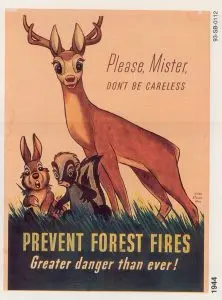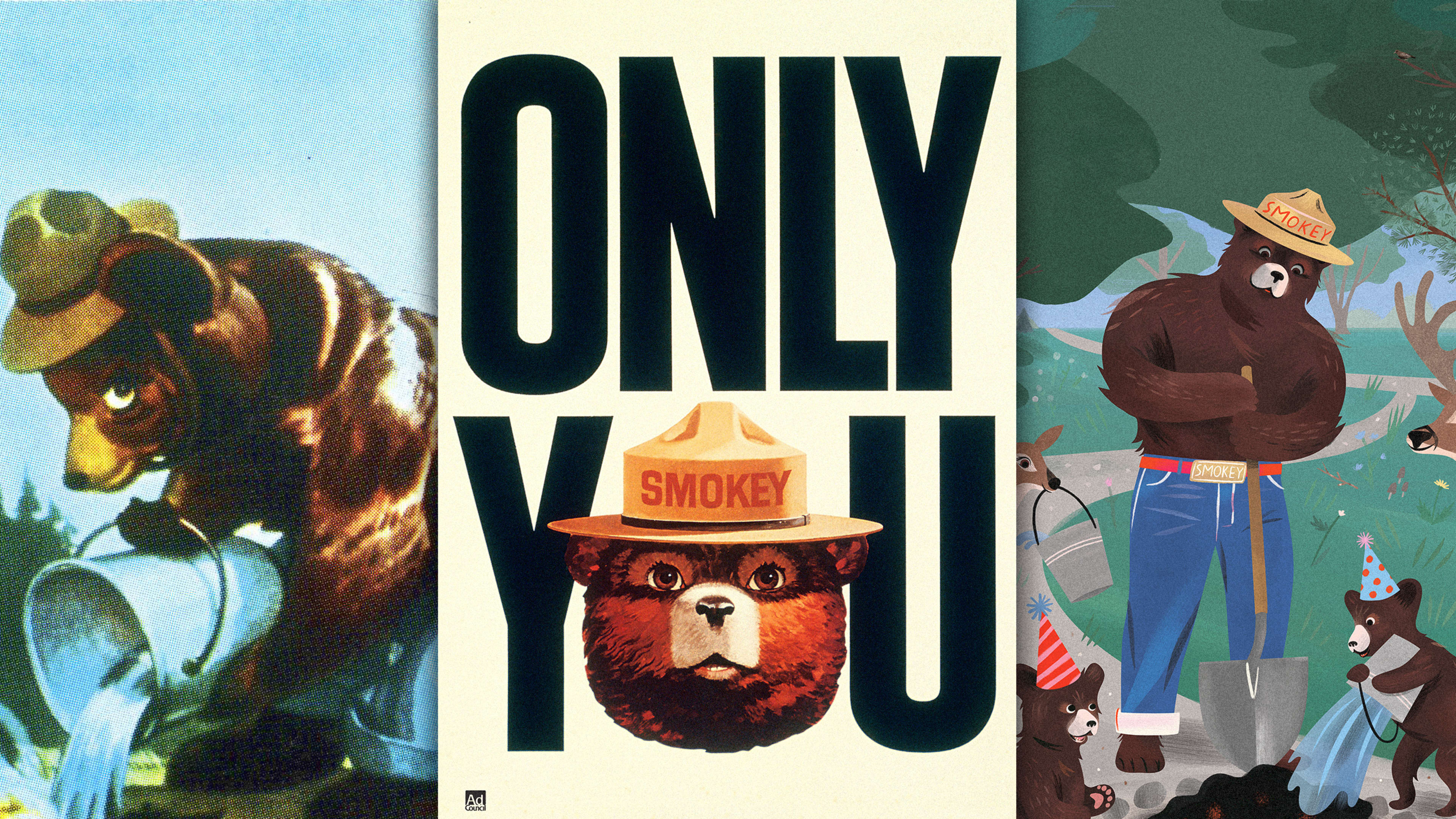Fire prevention mascot Smokey Bear officially turns 75 on August 9. He’s remained a PSA fixture for seven-and-a-half decades straight, since his shirtless debut dumping water over a campfire on a campaign poster in 1944. To celebrate, he’s being given a little modern spruce up, and the voice of some celebrity friends. The organization also dove into the archives to give a look at how Smokey has evolved in the last three-quarters of a century, and you can see some of those highlights above.
In one new ad, Betty White lends her voice to an animated Smokey emoji in a new promo that implores people not to park on long grass, because hot exhaust pipes can ignite it. White is one of several celebrities that the team behind Smokey has enlisted for new spots including Stephen Colbert, Al Roker, and Jeff Foxworthy. As another part of the celebrations, after several decades away, Smokey will also appear in giant balloon form at the Macy’s Day Parade in November this year. The rationale behind the revitalization is that when everyone knows your trademark look and catchphrase (that’s “Only You Can Prevent Wildfires”), it becomes important to find new ways to keep the message fresh—and stir up some nostalgia as well.
“Smokey is this American icon that in a lot of ways is a mirror to the culture at any given time,” says Amy Gibson-Grant, a vice president and campaign director at the Ad Council, the public service announcement nonprofit that controls the bear. That includes both his look and tone, but also the medium Smokey is working in, which has evolved from posters to radio, television, and now easily sharable social media gimmicks. “He’s a modern bear, you know,” she says. “Yes, he’s 75 years old, but he’s out there thumb-typing with the rest of us.”
So far, these efforts continue to be effective: Nearly 9 out of 10 wildfires are caused by humans, but Ad Council research shows that between 2011 and 2018, the frequency of conflagrations was actually down 14% compared to the previous decade. Seeing fewer fires start is especially important during a time when climate change, extra dry conditions, and urban density can combine to create outrageously deadly fires like California’s 2018 Camp Fire.

Disney wouldn’t license the character permanently, but the ads seemed to resonate with adults and kids, so the CFFP decided to create their own woodland character. It settled on Smokey, a black bear in his now-classic campaigner hat and dungarees. (Some initial rough drafts were pant-less—and took on a more cartoonish aesthetic.) The artist Albert Staehle created the first poster. He was succeeded by Rudy Wedelin, who honed the more classically anthropomorphic look.
“This is all hearsay, but they wanted a woodland creature that could have the ability to provide a message that can be respected but also has an approachable quality, you know, because of teddy bears and whatnot,” says Gibson-Grant. “He was the type of animal that could equally provide a message to adults and children alike.”
Since their inception, Smokey’s campaigns have been executed by the creative agency Foote Cone & Belding (now more hiply known as FCB). Early posters promoted stopping human error—those 9 out of 10 fires; the “Only You” slogan was officially adopted in 1947. In 2001, the campaign refined its language once again by changing forest fires to wildfires, in recognition that many disasters can spark outside of forests.
Urban lore has it that Smokey was inspired by a real bear that was itself rescued from a fire. That’s partly true, but it happened after the character was created. In 1950 firefighters found a live injured cub after a fire in the Capitan Mountains of New Mexico. The live animal “Smokey” was rehabilitated and lived at National Zoo in Washington, D.C., until his death in the mid-1970s. During that time, Smokey the bear became popular enough to warrant his own zip code, so postal carriers knew where to deliver the letters kids wrote it.
The only major public relations snafu the mascot has endured is what he is actually called. Most Americans would probably agree that his name is Smokey The Bear. However, the Ad Council insists it’s Smokey Bear. That goes back to a televised skit and song first performed midcentury crooner Eddy Arnold. The song’s original writers, a duo named Steve Nelson and Jack Rollins, added the “the” to make a chorus line more melodic, cementing decades of confusion that was perpetuated by later covers from Gene Autry and a 1970s boogie rock band called Canned Heat. An animated rendition with entirely new lyrics promoted by the Ohio Department of Natural Resources doesn’t seem to have been quite as catchy.
The idea of celebrities lending their voice to Smokey isn’t new. Through the years BB King, Dolly Parton, Leonard Nimoy, and Ray Charles have had the honor. Cheech and Chong even had their own spot in the ’80s. Gibson-Grant says the ultimate goal is infuse Smokey into pop culture in “unexpected ways so that as people are going through their daily lives they’re reminded of that message of personal responsibility.” That’s included appearances on decades of different stamps, as a clue on Jeopardy (Answer: “Smokey Bear spoke of forest fires until 2001 when his motto became ‘Only you can prevent’ these; humans cause most”) and, a few years ago, a collaboration with NASA to send a plush doll of the bear to the International Space Station.
Betty White obviously won’t take over official voiceover duties for Smokey. For more than a decade, that gig has belonged to the gravelly baritone of actor Sam Elliott. Currently 8 out of 10 people recognize Smokey’s image, so while the medium may change, giving his look and message a retirement party seems far from sight. One abiding lesson is the positively charged theme made it easier to outlive the war era. “Generally, we try to remember the likeability that he ultimately needs to exude, because that’s how he is most successful,” Gibson-Grant adds. “Yes, he has a stern message of responsibility, but it’s delivered in a very kindhearted way.”
Recognize your brand’s excellence by applying to this year’s Brands That Matter Awards before the early-rate deadline, May 3.



















